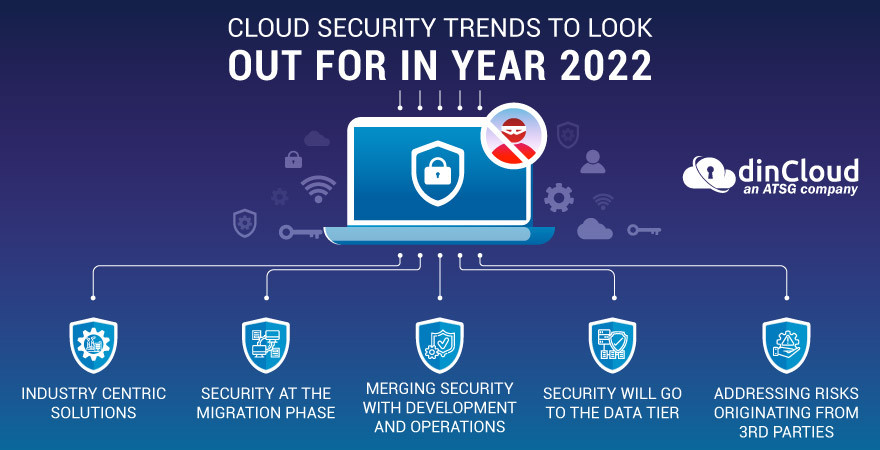The adoption of cloud solutions is on the rise across all key functional areas of the enterprise. As this trend picks up further pace in the year 2022, many industry experts believe this rapid move to the Cloud will also accompany security challenges.
In this post, we will consolidate some of the most notable security risks and challenges that are likely to surface in the year 2022, as enterprises rapidly migrate to cloud infrastructures and solutions.

Industry Centric Solutions
According to a recent study conducted by IBM, a sizeable 64% of top executives cited regulatory compliance as a major factor preventing their move to the Cloud. This stat also comes amidst a lot of tightening when it comes to regulations, such as EU’s GDPR.
Right now, we are also witnessing a host of different regulations governing the various sectors of a country or jurisdiction. Depending on the nature of the industry or sensitivity of the data involved, there is significant variation across regulatory frameworks.
Related: How to Develop a Holistic Approach Towards Cloud Security?
So, enterprises are finding it much easier, practical and efficient to adopt industry centric cloud solutions and Cloud Service Providers (CSP). Even otherwise, a CSP that serves a specific industry or niche has built its security in line with that industry’s specific needs.
Security at the Migration Phase
Not long ago, Cloud Security at the transition or migration phase was not that big of a deal. Enterprises used to adopt a “we’ll see when we get there” approach when migrating to cloud infrastructures, but this trend will now have to change in a big way.
To make the process of cloud migrations secure, seamless and unhindered, enterprises will have to factor in cloud security as early as the pre-migration stage. From thereon, the whole migration process needs to be overseen with security as a focal issue.
According to a survey of business leaders, it was found that nearly 77% of spending on cyber security was defensive in nature. This approach runs contrary to the path which focuses more on workload optimization in the Cloud, alongside compliance needs.
Related: How to Navigate Cloud Security Challenges in the Year 2022?
Merging Security with Development and Operations
This approach to cloud security is better known as DevSecOps. Some industry experts have gone to the extent to rearrange the above acronym to SecDevOps, to over emphasize the element of Security within the development and operational processes of an enterprise.
We will see this trend proliferate over this year, whereby security teams will have to work in close coordination with development and operations (DevOps) teams from the very beginning. This in turn will result in highly secure and optimized development processes.
By adopting the DevSecOps approach, enterprises will be able to bake security within the core of enterprise applications. According to a recent estimate by Gartner, nearly 70% of enterprise workloads could be deployed in the Cloud by as early as the year 2023.
With the incorporation of strong security measures at the development phase, enterprises will be in a much better position to migrate even sensitive workloads and data to the Cloud, such as financial records or patient’s medical records.
Related: No Better Time to Address Your Cloud Security Concerns
Security Will Go To The Data Tier
With every passing day, data is becoming a prized commodity. With the proliferation of Machine Learning (ML) and Artificial Intelligence (AI), enterprises are now truly able to extract actionable business insights from data.
However, with this extensive usability of data also come a host of cyber security challenges, data breaches being a major one of them. So, we expect that security will trickle down, right down to the data tier, especially for the data that is stored over the Cloud.
These data protection mechanisms include, but are not limited to, strong encryption both in transit and at rest, zero trust architectures and tokenization. By following this path, enterprises will be able to both protect and preserve their data housed over the Cloud.
Related: Multi-Cloud Security – An Emerging Challenge
Addressing Risks Originating from 3rd Parties
The scope of cloud deployments is going beyond the internal operations of an enterprise to incorporate external stakeholders, like 3rd parties which could be channel partners, vendors or suppliers. So, the security envelope will have to incorporate these entities as well.
Secondly, while the Cloud Service Provider (CSP) is primarily responsible for the security of the cloud infrastructure, the onus of protecting in-house resources, data, applications and workloads rests more on the deploying enterprises.
Related: Why is Cryptography So Important for Data and Cloud Security?
Conclusion
As cloud infrastructures evolve in a big way, we also expect cloud and enterprise security to follow suit. The bottom line is, enterprises will have to adopt a much more holistic approach towards cloud security, and that of their in-house workloads and processes.
If you are an enterprise that is finding it difficult to negotiate present day cyber security challenges, then dinCloud’s secure solutions might be the best fit for you.


